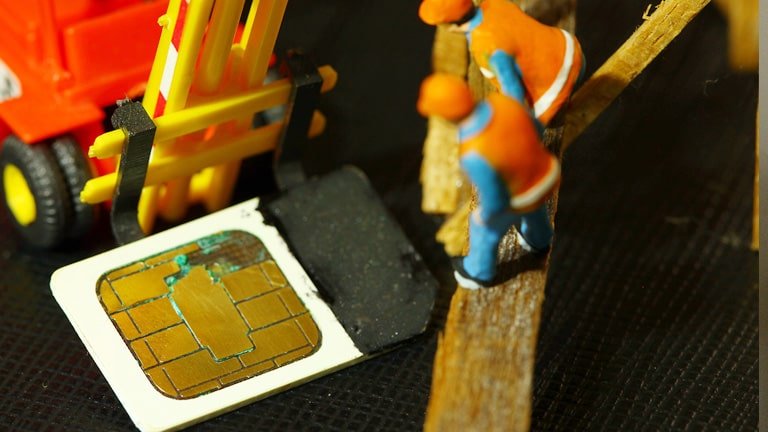
If your device uses a physical SIM card, you may be unable to access the internet and other mobile services if the SIM card gets damaged. The SIM card stores information such as your mobile number and other identification data that your carrier needs to provide your device access to its mobile services. SIM cards typically last over five years if well-handled, but damages are possible, especially if you swap them frequently.
If you are experiencing any issues accessing mobile network services, such as the internet, SMS, and calls, there is a chance that the problem lies with your SIM card. This article aims to help you figure out if your SIM card is damaged by exploring the signs and symptoms of SIM card damage, along with what you can do to resolve the issue. Whether you are a tech-savvy individual or a newcomer to mobile technology, this article will empower you with the information you need to understand and address SIM card damage issues.
How do I determine if my SIM card is damaged?
If your SIM card is damaged, there are certain unusual behaviors you will experience with your phone, depending on the operating system. Let’s explore what you may experience if your SIM card gets damaged.
iPhone
- Signal and Connectivity Issues: One of the most noticeable signs of a damaged SIM card is the loss of network connectivity. You may experience weak or no signal, leading to difficulties in making calls, sending text messages, or accessing the internet.
- Error Messages: Another common indication of SIM card damage is the appearance of error messages such as “No SIM installed” or “No service.” These messages appear when the phone fails to recognize the SIM card or establish a connection with the network. If the SIM card is damaged, these errors will persist even when you reboot the device.
- Contact List Corruption: A damaged SIM card may result in the corruption or loss of contacts stored on the card. This can make it challenging to access or retrieve important phone numbers, potentially leading to communication difficulties.
- Call Quality Issues: In some cases, a damaged SIM card can cause deterioration in the sound quality during calls. You might experience dropped calls, static, or difficulty hearing the other person on the call.
- Delayed Text Messages and Calls: When the SIM card is damaged, you might notice delays in receiving text messages and calls. Messages might not reach your device promptly, impacting your ability to respond to them in real-time.
Samsung & Google (Android)
- Function freeze: A damaged SIM card may cause your Samsung or Google Android phone to freeze or become unresponsive at times. You may notice that every icon or feature that you tap doesn’t respond. This can happen when the phone attempts to access the SIM card but encounters errors due to physical damage or data corruption.
- Password authentication messages: A damaged SIM card may prompt you to enter your PIN or unlock code more frequently than usual. Such messages will usually appear when the SIM card loses its connection intermittently, causing the phone to request the PIN to verify its authenticity.
How do I know if the SIM card has been damaged?
To check if your SIM card is damaged, you can start by answering the following questions;
Can I use the local network & cellular data?
- Check the signal strength: Look for the signal bars or indicators on your smartphone’s screen. If you see that you have a good signal and are connected to a local network (e.g., 4G, 3G, or LTE), then your SIM card is likely functioning correctly in terms of network connectivity. If not, your SIM card could be damaged or have issues.
- Check cellular data: If you have a data plan, try accessing the internet or using data-reliant apps. Ensure to check some of the most reliable sites, such as google.com or apple.com. If you find problems connecting to these sites, then your SIM card could be damaged.
Can I receive text messages immediately without any delays?
- Send test messages: You can find this out by asking a friend or family member to send you a text message. If you receive the message promptly and without any delay, it suggests that your SIM card is functioning correctly for text messaging.
- Delayed messages: If you notice delays in receiving text messages or if you receive messages in bursts after a prolonged period of no activity, it could indicate a damaged SIM card or any other issues associated with your SIM card.
Can I make and receive calls?
- Make test calls: Try calling a few people to determine whether the calls are successful and clear. If the calls go through without any issues and you can hear the other person clearly, your SIM card is likely working well for voice calls.
- Receive calls: You may also test if you can receive calls by asking a friend or family member to call you. Check if you can receive calls without any problems.
How long does a SIM card last? When do I have to replace it?
For starters, SIM cards do not have an indefinite lifespan. Since these cards are physical cards, they can wear out or become obsolete over time. The typical lifespan of a SIM card can be over five years but may vary depending on various factors, including the quality of the card, usage patterns, and environmental conditions. Here are some factors that affect the longevity of the SIM card to help you determine when it may be appropriate to replace it;
- Physical wear and tear: Repeated swapping of SIM cards can cause wear on the metal contacts, potentially leading to connectivity issues.
- Technological advancements: Over time, new generations of SIM cards are introduced, such as the transition from the standard SIM to micro-SIM, nano-SIM, and now eSIM (embedded SIM). Network advancements such as moving from 3G to 4G may also require you to upgrade to a new SIM card to access the new network capabilities.
- Network support: It is also possible that some mobile carriers can phase out support for older SIM cards, forcing users to upgrade to newer versions compatible with their networks.
- SIM card expiration: Some prepaid SIM cards or temporary SIM cards for travelers may have an expiration date. If you don’t use the SIM card within the specified period, it may become inactive, and you might need to get a new one.
- Data corruption and degradation: Over time, the data stored on the SIM card can suffer from corruption or degradation. This can lead to issues like contact list corruption or delayed text messages.
When can SIM cards be damaged?
SIM card damage happens due to several reasons. Some reasons for SIM card damage include the following;
- Water or liquid exposure: Water can damage the delicate electronic components of a SIM card.
- Heat and extreme temperatures: Exposing a SIM card to high temperatures or extremely low temperatures can cause damage to the card’s components.
- Bending or physical damage: SIM cards are fragile, and bending them can lead to permanent damage or even breakage.
- Corrosion: Exposure to corrosive substances or environments can harm the metal contacts on the SIM card, affecting its functionality.
- Static electricity: A static electricity discharge can damage the electronic components of a SIM card.
- Dust and dirt: Accumulation of dust or dirt on the metal contacts can hinder connectivity and cause issues.
- Support expiration: As mentioned earlier, if your mobile carrier no longer supports a specific type of SIM card in your device, it will no longer work.

How to proactively prepare for SIM card damage?
To avoid having your SIM card damaged when you need it the most, there are some proactive measures that you must take to minimize the risk of damage. Here are some steps you can take:
Handle with care
Always handle your SIM card with care. Avoid bending, scratching, or dropping it. When inserting or removing the SIM card from your phone, do it gently to avoid damaging the metal contacts.
Keep it dry
If you’re not currently using the SIM card, ensure it is stored in a dry place to avoid exposing it to water or other liquids. You should also periodically clean the metal contacts on your SIM card using a soft, dry cloth whenever your SIM card spends a couple of weeks without being used.
Backup your data
Regularly back up the data on your SIM card, such as contacts and messages. This will allow you to restore this data in case the SIM card gets damaged.
Consider eSIM
If your phone supports eSIM technology, consider switching to eSIM instead of a traditional SIM card. eSIM is an embedded SIM that eliminates the need for a physical card. It has several benefits over traditional SIM cards. Some of the benefits include the following;
- Damage-resistant: eSIMs are less susceptible to physical damage since they are embedded within the device and not exposed to external elements like physical SIM cards.
- Securely kept information: With eSIM, your data, including contacts on the eSIM, are securely stored within the device’s hardware.
- Eco-friendly: eSIMs can be more environmentally friendly as they reduce the need for physical production, packaging, and disposal associated with traditional SIM cards.
- Flexibility: With eSIMs, you can switch between different carriers or plans without needing to physically change SIM cards.
Final thoughts
Physical SIM cards can get damaged due to various reasons, as mentioned in this article. If you notice any signs of a damaged SIM card, it’s crucial to address the issues promptly to maintain access to core network services, such as calls, SMS, and the Internet. For an enhanced experience, consider switching to eSIM if your device supports it.
eSIM offers several advantages, one of which is its resistance to physical damage, unlike traditional SIM cards. Moreover, eSIMs are particularly beneficial for travelers and individuals who frequently switch SIM cards.
Frequently asked questions about damaged SIM card
How do you fix a damaged SIM card?
Unfortunately, there is no practical way to repair a physically damaged SIM card. If the SIM card is scratched, bent, or exposed to water, you will have to replace it with a new one or upgrade to eSIM if your phone supports eSIM technology.
How does a SIM card get damaged?
A SIM card can get damaged due to various reasons, including physical damage, water or liquid exposure, corrosion, extreme temperatures and static electricity discharge.
Can a bad SIM card cause no service?
Yes, a bad or damaged SIM card can cause “No service” or loss of network connectivity on your phone. If the SIM card is not functioning correctly, you will not be able to access mobile network services like calls, SMS, and internet access.
Can I get a new SIM card if mine is damaged?
If your SIM card is damaged or not working properly, you can get a replacement SIM card from your mobile carrier. Most carriers offer card replacements at no cost or a small fee.
How can I tell if my SIM card is damaged?
To check for a damaged SIM card, observe issues such as the “No SIM installed” or “No service” message on your phone, difficulty making or receiving calls, delayed or missing text messages, issues with data connectivity or internet access, and physical damage or visible scratches on the SIM card.
Can you get a replacement SIM card?
Yes, you can get your SIM card replaced by your mobile carrier if your current SIM card is damaged. Contact your carrier’s customer support, explain the situation, and they will assist you in obtaining a replacement SIM card. Upgrading to eSIM would be the best alternative to avoid facing similar issues in future. Of course, you will need an eSIM-capable device to upgrade to eSIM.
